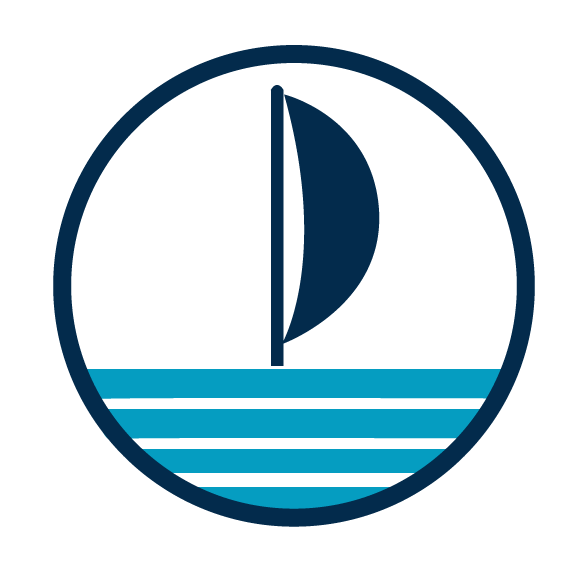Beginner’s Guide to the Points of Sail

Sailing is a fantastic way to connect with nature, enjoy the water, and challenge yourself with something new. But before you can become a confident sailor, it’s essential to understand the “points of sail”—the different angles at which your boat can sail relative to the wind. Don’t worry if it sounds complicated; we’ll break it down step by step so you can hit the water with confidence.
What Are Points of Sail?
Let’s start with the basics. The term “points of sail” refers to the different directions your boat can sail in relation to the wind. Understanding these directions is crucial because it helps you know how to position your sails, steer your boat, and most importantly, stay safe on the water.
When you know the points of sail, you’ll be able to control your boat better, sail more efficiently, and avoid common beginner mistakes.
Understanding the Wind
Before we dive into the points of sail, let’s talk about the wind. As a sailor, the wind is your best friend. But it’s also important to understand the difference between two key terms: true wind and apparent wind.
- True Wind: This is the wind that you feel when you’re standing still on land or in a stationary boat.
- Apparent Wind: This is the wind you feel when you’re moving. It’s a combination of the true wind and the wind created by your boat’s motion.
Knowing which direction the wind is coming from is the first step in setting up your sails correctly. To figure this out, look at flags, telltales, or even feel the wind on your face.
The Basic Points of Sail
Now that we’ve covered the wind, let’s explore the different points of sail. Imagine the wind as a clock face around your boat. Each point of sail is like a different time on that clock, depending on where the wind is coming from.

- No-Sail Zone (In Irons)
- The no-sail zone is directly into the wind, typically about 30-40 degrees on either side. If you try to sail here, your sails will flap, and your boat won’t move forward. This is called being “in irons.” It’s like trying to push a shopping cart straight into a strong wind—not much fun and not very effective!
- Close-Hauled
- This point of sail is as close to the wind as you can sail, usually around 30-45 degrees, and at the edge of the no-sail zone. It’s one of the most challenging for beginners because it requires precise sail trimming and steering. But once you get the hang of it, close-hauled sailing can be very rewarding.
- Close Reach
- If you ease off the wind just a little bit more from close-hauled, you’re in a close reach. This angle is slightly less challenging, but you still need to keep your sails trimmed tightly.
- Beam Reach
- A beam reach is when the wind is coming directly from the side of your boat (90 degrees). This is often the fastest and most comfortable point of sail, perfect for when you want to relax a bit and enjoy the ride.
- Broad Reach
- Sailing with the wind coming from behind at an angle (about 135 degrees) is called a broad reach. It’s a fun, steady point of sail and a favorite for many sailors.
- Running (Downwind)
- When the wind is directly behind your boat, you’re “running” downwind. This can be a bit tricky because the risk of an accidental gybe—when the boom swings rapidly from one side to the other—is higher. But with some practice, it becomes a thrilling point of sail.
Trimming Your Sails
For each point of sail, you’ll need to adjust your sails to catch the wind just right. This is known as sail trim. The closer you sail to the wind, the tighter you’ll need to trim your sails. As you move further away from the wind, you can ease the sails out.
Think of sail trim as the volume knob on a radio—you’re adjusting it to get the best sound (or in this case, the best performance from your boat).
Common Maneuvers: Tacking and Jibing
Two important maneuvers in sailing are tacking and jibing (or gybing in the UK).
- Tacking involves turning the bow (front) of the boat through the wind, usually when you’re sailing close-hauled. It’s a controlled way to change direction and continue sailing upwind.
- Jibing is when you turn the stern (back) of the boat through the wind, typically when you’re sailing downwind. Gybing requires careful handling to avoid that accidental gybe we mentioned earlier.
Safety Tips
Understanding the points of sail also helps you stay safe on the water. Here are a couple of safety tips:
- Avoid the No-Sail Zone: If you find yourself in irons, don’t panic. Gently steer the boat away from the wind and adjust your sails to catch the wind again.
- Prevent Accidental Jibes: When running downwind, keep an eye on the boom and steer carefully to avoid an accidental jibe. Avoid running straight down wind, as sudden shifts of wind or a lapse in steering can lead to accidental jibes. You can use a preventer, a line that holds the boom in place, as an extra safety measure.
Visual Aids: Diagrams and Wind Roses
To help visualize the points of sail, a diagram like the one above showing the wind direction and corresponding sail positions can be incredibly useful. If you’re a visual learner, look for a “wind rose” diagram, which shows the 360-degree relationship between your boat and the wind. These tools can make understanding the points of sail much easier.
Practice Makes Perfect
Like any new skill, practice is key to becoming a proficient sailor. Start with short trips on calm days, and don’t be afraid to make mistakes—that’s how you learn! If possible, sail with an experienced friend or instructor who can offer tips and guidance.
Conclusion
Understanding the points of sail is one of the most important skills for any beginner sailor. By learning the different angles, adjusting your sails properly, and practicing key maneuvers, you’ll soon be navigating the waters with confidence and ease. Now that you understand the points of sail, check out our guide to basic sailing maneuvers.


